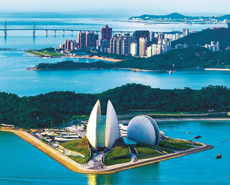
Magnesia to stand firm in Q4
----Interview with Jiang Chunyong
Vice General Manager
Yingkou Guanhao Refractory Material Co., Ltd.
Vice General Manager
Yingkou Guanhao Refractory Material Co., Ltd.
Asian Metal: Thank you for accepting Asian Metal's interview. First of all, could you please briefly introduce your company from the aspects of production line, scale, capacity, output, etc?
Mr. Jiang: Our head office Dashiqiao Huasheng Refractory Materials Co., Ltd., founded in 1984, now covers an area of 13,000 square meters, of which 5,400 square meters are the construction area. It is a specialized production company which is engaged in the businesses of mining, smelting and processing and focuses on the development and production of various kinds of high-quality fused magnesia. Our company Yingkou Guanhao Refractory Material Co., Ltd., which mainly produces high-quality fireproof magnesia carbon bricks, has attached great importance to technology and quality since its very beginning and has been qualified for importing and exporting businesses since 1997. Our company can not only produce under international standards ZBD52001-90, but also offer customized products. In order to broaden the international market, our company constantly strengthens its internal management, adjusts its product structure and provides customized products, such as ordinary sand and high calcium sand with various grain sizes.

Our company's main businesses include two parts: raw materials and products.
In terms of magnesia, we primarily produce fused dicalcium magnesia with 8 furnaces and have an annual capacity of 20,000t, but our monthly output of the material has decreased to 1,000t on average restrained by the supply shortage of magnesite and strict environmental inspections. In addition, we also have an annual production capacity of 25,000t of dead burned magnesia with two kilns and currently produce 2,000t of the material per month.
As for products, we mainly produce magnesia carbon bricks with fourteen pressing machines which have an annual capacity of 30,000t.

Asian Metal: The export quotas on magnesia were abolished in early 2017, how do you think of the changes in the export market of magnesia? And how were your company's exports in the first half of 2017?
















